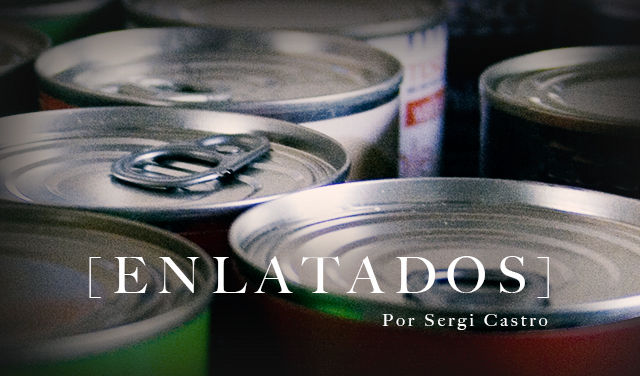Treats in a Tin

“Whites and rosés go with canned fish, shellfish and most vegetables. Light or medium-bodied reds pair well with canned meats.”
We're not going to talk about a new kind of wine container—besides, “wine in a can” (or in an aluminum bottle) wouldn't exactly be news nor was it particularly popular with consumers.
We're going to talk about the “rediscovery” of canned foods by big-name chefs (and those aspiring to be so) and avant-garde cuisine restaurants. And let's not forget time-honored local bars, immune to trends and fads, where opening a can of cockles, tuna or pickled mussels is a daily routine at the hour of the aperitif.
For those of you who don't know the history of the humble tin can most of us take for granted, here's an interesting fact. Prior to 1780, we only knew of three food preservation methods: drying, salting and smoking. All three are based on the principle of dehydrating the food in question and thus part of its nutritious qualities as well. Vacuum-packing fresh, cooked food products was first invented by a Frenchman named Nicolas François Appert. His invention earned him an important prize at a food preservation competition launched by none other than Napoleon Bonaparte. The French leader was concerned about feeding his troops, which were engaged in military campaigns across Europe at the time. It wasn't until 1810, however, that metal began replacing glass as the preferred canning material.
The most curious detail in all of this canning business is the can opener, which wasn't invented until 1855. So, how were cans opened before then? With a chisel and hammer or a bullet and bayonet, because at first cans were primarily used to feed soldiers.
For many of us, our memory still retains the taste and smell of canned fruit in Christmas hampers, as well as other delicacies like certain shellfish or asparagus, which many people prefer canned over fresh. Convenience and affordability have also contributed to canned food surviving until the present day.
THE WINES
And what does wine have to do with any of this? In and of itself, wine is a type of canned food, usually preserved in glass with a cork, which allows it to evolve and contributes to its longevity. Which is to say, the first pairing of wine and canned food is conceptual in nature.
All right, let's be serious. What do we need to pay attention to when matching wine and canned foods? Obviously, our main focus needs to be on the contents of the can. Although there are differences in texture and certain flavors between canned and fresh food, the same premises in terms of flavor combinations still apply when pairing.
Whites and rosés go with canned fish, shellfish and most vegetables. Light or medium-bodied reds pair well with canned meats.
Top-quality tuna or juicy slices of albacore pair beautifully with well-bodied whites briefly fermented or aged in oak. ATRIUM CHARDONNAY would be an ideal choice, but depending on the ingredients involved in the combination, the array of possibilities opens up considerably. Tuna-stuffed avocados have me leaning toward a white with higher acidity, like SANTA DIGNA SAUVIGNON BLANC, to compensate the fatty texture of the fruit. Combining the fish with roasted peppers, however, would allow for a medium-bodied red like CELESTE ROBLE or CORONAS.
Shellfish like cockles, razor clams, clams, etc. combine wonderfully with an Albariño like our PAZO DAS BRUXAS, which brings out the fine flavors of these delicacies without overpowering them. Take care, however, when it comes to canned food that has been pickled: the use of vinegar—that archenemy of wine—calls for fruitier wines to contrast the acetic acid. The best choice is VIÑA ESMERALDA, that popular (and yet incomparable) blend of Muscat and Gewürztraminer.
If we opt for canned vegetables or legumes, watch out for foods that make for a complicated match, such as asparagus or artichokes. That being said, the act of cooking and preserving makes them easier to work with than their fresh counterparts. Aromatic, somewhat rounder whites are always a good ally, not only for asparagus and artichokes, but also for a humble dish of peas. VIÑA SOL is an excellent match for these foods. A salad with roasted piquillo peppers harmonizes in interesting aromatic ways with a red like SANGRE DE TORO or a light Cabernet like SANTA DIGNA CABERNET SAUVIGNON. But take note: be judicious if you decide to add garlic to this delicious salad.
Canned meats have become gourmet items. Canning makes it much easier to enjoy classics like tripe, quail, pork cheeks and even oxtail, not simply as ingredients, but as dishes in all their splendor. We rarely prepare these recipes nowadays, because of how long they take to cook or how labor-intensive their preparation is, and we often lack the time needed to do so. Slow cooking releases the meat's juices, thus giving the texture a gelatinous quality that absorbs the tannins in the wine.
Partridge and quail, especially when pickled, go best with aromatic whites that have only been aged briefly. How about pairing them with FRANSOLA?
Have no fear in pairing cans of stewed red meat with full-bodied reds like GRAN CORONAS or SALMOS. If you prefer lighter reds, however, ALTOS IBÉRICOS or CELESTE CRIANZA will also do very nicely.
Canned food has never gone out of style, because of how practical it is. Take a look in your pantry—I'm sure you have some right there. Now they've become prized gastronomic items with which you can make magnificent culinary creations and, of course, pair them with BODEGAS TORRES wines.
